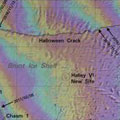Following the appearance of a large crack in the ice shelf close to the Halley VI research station in Antarctica, information from the Copernicus Sentinel-1 and Sentinel-2 satellites helped to decide to close the base temporarily.
Following the appearance of a large crack in the ice shelf close to the Halley VI research station in Antarctica, information from the Copernicus Sentinel-1 and Sentinel-2 satellites helped to decide to close the base temporarily.
Nourished by an inflow of ice from grounded glaciers and snow accumulating on its surface, Brunt Ice Shelf is a floating ice sheet in the Weddell Sea Sector of Antarctica. The floating ice moves steadily towards the ocean, where it occasionally calves off as icebergs.
Cracks often appear on shelves as the ice deforms. However, rapidly expanding cracks indicate impending calving.
Since the Halley VI base of the British Antarctic Survey was only 17 km from the crack that appeared last October, Enveo - a company that uses satellite data for cryosphere studies - and the Survey used radar images from Sentinel-1 and optical images from Sentinel-2 to monitor the situation.
